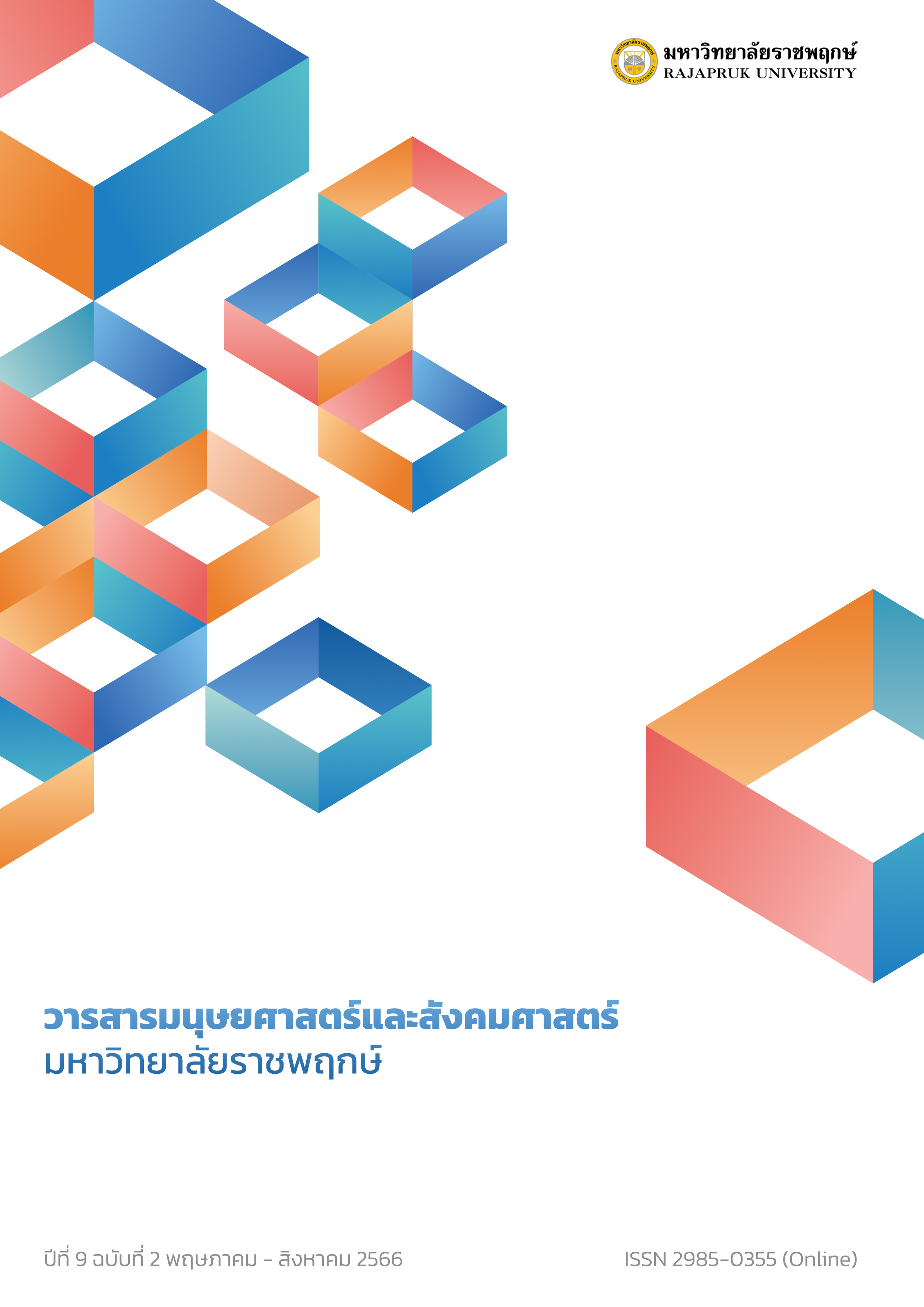Adaption Strategy to Social Banking of The Islamic Bank of Thailand
Main Article Content
Abstract
The objective of this research was to study the model of adaptation strategy to social banking of the Islamic Bank of Thailand. It was a qualitative research using Delphi technique. Data were collected from relevant documents and in-depth interviews with 17 experts in social banking. They were selected based on purposing sampling. The results revealed that there are seven key strategies for the Islamic Bank of Thailand to adapt to social banking: 1) organizational innovation strategy, 2) organizational learning strategy, 3) organizational culture strategy, 4) internal communication efficiency strategy, 5) organizational resilience to change strategy, 6) change leadership strategy, and 7) employee engagement strategy. The strategies can create a balance between traditional and new financial services to be consistent with society, culture, environment and economy while increasing competitiveness of Islamic finance and expanding access to services in accordance with Islamic principles.
Article Details
References
โกศล จิตวิรัตน์. (2561). โมเดลการปรับตัวขององค์การธุรกิจที่ได้รับผลกระทบจากการทำลายล้างของเทคโนโลยีดิจิทัลในศตวรรษที่ 21. วารสารสมาคมนักวิจัย, 23(2), 74-87.
ธงชัย ทองมา และ ธีระวัฒน์ จันทึก. (2558). การบริหารจัดการความเสี่ยงกับการบริหารการเปลี่ยนแปลง: องค์การในยุคโลกาภิวัตน์. Veridian E-Journal, Slipakorn University, 8(3): 596- 621.
ธนาคารแห่งประเทศไทย. (2563). บทบาทของ Non-Bank ต่อการเข้าถึงบริการทางการเงินของประชาชน. ค้นเมื่อวันที่ 20 มิถุนายน 2563, จาก https://www.bot.or.th/Thai/ResearchAndPublications/articles
ธนาคารอิสลามแห่งประเทศไทย. (2562). ข้อมูลทางการเงิน: รายงานประจำปี 2562. ค้นเมื่อวันที่ 28 กุมภาพันธ์ 2563, จาก http://www.Ibank.co.th
ธนาคารอิสลามแห่งประเทศไทย. (2563). ข้อมูลทางการเงิน: รายงานประจำปี 2563. ค้นเมื่อวันที่ 9 เมษายน 2563, จาก http://www.Ibank.co.th
ธวัช นุ้ยผอม. (2017). การเข้าถึงแหล่งทุน กรณีศึกษามุสลิม ณ จังหวัดชายแดนภาคใต้ของประเทศไทย. Knowledge management; 10 Washington, D.C.: World Bank Group.
ธิดารัตน์ อริยะประเสริฐ สุภัททา ปิณฑะแพทย์ และ ธีรวุฒิ บุณยโสภณ. (2563). การพัฒนารูปแบบการจัดการองค์กรสำหรับธุรกิจอุตสาหกรรมไทยในยุคเศรษฐกิจพลิกผัน. วารสารวิชาการพระจอมเกล้าพระนครเหนือ, 30 (2): 314-323.
ธิดารัตน์ อริยะประเสริฐ. (2564). วิถีการปรับตัวสู่การเป็นองค์การธุรกิจอุอุตสาหกรรมที่ปราดเปรียวในยุคเศรษฐกิจพลิกผัน. วารสารพัฒนาธุรกิจและอุตสาหกรรม, 1(1): 1-11.
ภคพร เปลี่ยนไพโรจน์ และมณฑล สรไกรกิติกูล. (2562). มุมมองและการปรับตัวของพนักงานในยุคบริการทางการเงินดิจิทัล. วารสารการจัดการธุรกิจมหาวิทยาลัยบูรพา, 8(1): 62-80.
มนชยา อุรุยศ. (2553). โครงการ การศึกษานโยบายเพื่อการพัฒนาการเงินอิสลามของประเทศไทย. ชุดโครงการ “ความสัมพันธ์ทางเศรษฐกิจระหว่างประเทศกับประเทศตะวันออกกลาง”. กรุงเทพฯ: สำนักงานกองทุนสนับสนุนการวิจัย.
รงค์ บุญสวยขวัญ. (2560). การบริหารการเปลี่ยนแปลง: กรอบแนวคิดเพื่อการวิจัย Change Management: Conceptual Framework. สารอาศรมวัฒนธรรมวลัยลักษณ์ มหาวิทยาลัยวลัยลักษณ์, 1(1): 48-60.
วัลยา รุกขภิบาล. (2553). กลยุทธ์การบริหารเพื่อการขยายตัวของธุรกิจสื่อนิตยสารในเครืออมรินทร์ ระหว่างปี พ.ศ.2541 ถึงปัจจุบัน. ค้นเมื่อวันที่ 15 ตุลาคม 2562, จาก https://digital.library.tu.ac.th/tu_dc/frontend/Info/item/dc:121196.
วัลลภ รัฐฉัตรานนท์. (2562). การวิจัยอนาคตโดยใช้เทคนิคเดลฟาย. วารสารสหวิทยาการวิจัย: ฉบับบัณฑิตศึกษา, 8(1): 1-10.
ศรัณย์ ศานติศาสน์ และ อัญชนา พลศร. (2018). สถาบันการเงินอิสลามกับการเติบโตทางเศรษฐกิจในสามจังหวัดชายแดนภาคใต้. Journal of Management Sciences, 35(1): 27-50.
เศรษฐพงค์ มะลิสุวรรณ. (2560). หุ่นยนต์แทนแรงงานมนุษย์...มันคือความจริง. ค้นเมื่อวันที่ 5 กันยายน 2563, จาก http://www.nationtv.tv/main/content/economy-business/378553940/
สฤณี อาชวานันทกุล. (2560). การเติบโตของ Fintech กับโอกาสการสร้างเศรษฐกิจที่พัฒนาอย่างทั่วถึง. ค้นเมื่อวันที่ 15 สิงหาคม 2563, จาก http://www.salforest,com/knowledge/fitech-financial-access
สำนักงานคณะกรรมการนโยบายรัฐวิสาหกิจ. (2563). แผนยุทธศาสตร์รัฐวิสาหกิจ. ค้นเมื่อวันที่ 18 มีนาคม 2563, จาก http://www.sepo.go.th/
สำนักงานเศรษฐกิจการคลัง. (2558). นวัตกรรมในการพัฒนาระบบการเงินภาคประชาชน: แผนที่การเข้าถึงบริการทางการเงินระดับฐานราก. กรุงเทพฯ: สำนักงานเศรษฐกิจการคลัง.
อนุชา ลาวงค์. (2563). รูปแบบเชิงยืนยันการบริหารจัดการเชิงกลยุทธ์ของมหาวิทยาลัยราชภัฏในกลุ่มภาคตะวันออกเฉียงเหนือ. Journal of Modern Learning Development, 5(2): 159-177.
Burke, W. W., & Litwin, G. H. (1992). A causal model of organizational performance and change, Journal of Management, 18(3): 523–545.
Dermine, J. (2017). Digital Disruption and Bank Lending, European Economy, 2017, 2: 63-76.
Drummer, D. Jerenz, A., Siebelt, P., Thaten, M. (2016) FinTech–Challenges and Opportunities. ค้นเมื่อวันที่ 15 พฤศจิกายน 2563, จาก ttps://www.mckinsey.com/
FI2020. (2016). Financial Inclusion 2020 Progress Report. Retrieved on February, 2nd, 2020, from http://www.fi2020progressreport.org/technology/
Gartner. (2017). Digital Disruption. Retrieved on April, 9th, 2020, from http://www.gartner.com/it-lossary/digital-disruption
Gomber, P., Kauffman, R.J., Parker, C., & Weber, B. W. (2018). On the Fintech Revolution: Interpreting the forces of Innovation, Disruption and Transformation in Financial Services. Journal of Management Information Systems, 35(1): 220-265.
IMF. (2016). Leveraging Financial Technology for the Underbanked. Retrieved on January, 12th, 2020, from http://www.imf.org/
Islamic Financial Services Board. (2017). Overview of The Global Islamic Finance Industry Malaysia. Retrieved on February, 14th, 2020, from https://www.ifsb.org/
Islamic Financial Services Board. (2020). Overview of The Global Islamic Finance Industry Malaysia. Retrieved on May, 9th, 2020, from https://www.ifsb.org/
Life SREDA VC. (2016). Money of The Future Result of 2015 Trends for 2016. Retrieved on June, 1st, 2020, from https://www.yumpu.com/en/document/read/55363299/of-the-future
Macmillan, T. T. (1971). The Delphi Technique. Paper Presented at the annual meeting of the California Junior Colleges Associations Committee on Research and development, Monterey, California. 3-5.
Marian, N., Marius, G., & Oliviana, B. (2012). The Impact of Change Management in Organizations–a Survey of Methods and Techniques for a Successful Change, International Comparative Management, 13(1): 5-16.
Miles, R. and Snow, C.C. (1978). Organizational Structure and Process. Academy of Management, 3(3): 412-419.
Robert, C., Ehrbeck, T. & Holle, N. (2014). Financial Inclusion and Development: Recent Impact Evidence. Washington, D.C.: CGAP.
Rouse, M. (2016). Customer experience management (CEM or CXM). Retrieved on April, 1st, 2020, from http://searchsales-force.techtarget.com/definition/customer-experience-management-CEM.
Rovinelli R. J. & Hambleton R. K. (1977). On the Use of Content Specialists in the Assessment of Criterion-Referenced Test Item Validity. Dutch Journal of Educational Research, 2: 49-60.
Schermerhorn, J. R. (2005). Management. New York: John Wiley and Sons.
Sia, S. K., Soh, C., and Weill, P. (2016). How DBS Bank Pursued a Digital Business Strategy, MIS Quarterly Executive, 15 (2): 1-17.
Williamson, E. G. (1950). The Trait - Factor Theory. New York: McGraw-Hill.


